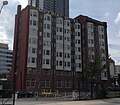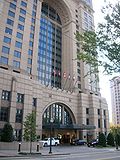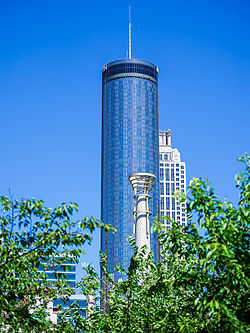| Name | Image | Built | Architect | Notes |
|---|
| Atlanta Hotel | | 1846 | | The first hotel to be built within Atlanta's city limits. Destroyed in 1864 during the Burning of Atlanta. |
| Washington Hall | | 1846 | | Built shortly after the Atlanta Hotel. Destroyed in 1864 during the Burning of Atlanta. |
| Trout House |  | 1849 | | Confederate President Jefferson Davis gave a speech here in 1861. Destroyed in 1864 during the Burning of Atlanta. |
| Kimball House |  | 1870 | William Parkins | Built on the site of the Atlanta Hotel. Destroyed by a fire in 1883 and rebuilt in 1885. Razed in 1959. |
| Markham House |  | 1875 | | Built by William Markham. Destroyed by fire in 1896. |
| Hotel Aragon |  | 1892 | | Demolished in 1930. |
| Majestic Hotel |  | 1898 | | Demolished in 1927. |
| Piedmont Hotel |  | 1903 | Willis F. Denny | Underwent renovations in 1928–1929. Demolished in 1965. |
| Candler Building |  | 1906 | George Stewart George E. Murphy | Tallest building in the city at the time of its completion. Designated a National Historic Landmark in 1977. Repurposed in 2016 for use as a boutique hotel. |
| Terminal Hotel |  | 1906 | | Built by Samuel M. Inman across from Terminal Station. Part of the Hotel Row district in downtown. Destroyed by fire in 1938. |
| Imperial Hotel |  | 1910 | Edward E. Dougherty R. M. Walker | Abandoned in 1980. Added to the National Register of Historic Places in 1983. Currently serves as low-income housing. |
| Georgian Terrace Hotel |  | 1911 | William Lee Stoddart | Declared a contributing property to the Fox Theatre Historic District in 1978. Underwent renovations in 1991. |
| Ellis Hotel |  | 1913 | William Lee Stoddart | Originally known as the Winecoff Hotel. Site of the 1946 Winecoff Hotel fire. Reopened in 1951 as the Peachtree on Peachtree Hotel. Later served as housing for the elderly. Reopened in 2007 with its current name. Added to the National Register of Historic Places in 2009. |
| Hotel Ansley |  | 1913 | Jerome B. Pound | Renamed the Dinkler Plaza Hotel in 1953. Razed in 1973. |
| Connally Building |  | 1916 | William Lee Stoddart | Originally built as an office building. Converted to a hotel in 1990 following a renovation and the addition of eleven stories. Currently houses a Fairfield by Marriott. |
| Glenn Building |  | 1923 | Wadley B. Wood | Originally built as an office building. Converted to a boutique hotel in 2006. Added to the National Register of Historic Places in 2008. |
| Atlanta Biltmore Hotel and Biltmore Apartments |  | 1924 | Schultze & Weaver | Operated by Sheraton Hotels and Resorts between 1967 and 1979. Added to National Register of Historic Places in 1980. Converted to an office building in 1999. |
| Briarcliff Hotel |  | 1924 | G. Lloyd Preacher | Built by Asa G. Candler Jr. as a luxury apartments and hotel. Originally known as The Seven-Fifty. Added to the National Register of Historic Places in 1982. |
| Clermont Motor Hotel |  | 1924 | | Originally built as the Bonaventure Arms Apartments, converted into a hotel in 1939. Famous for the Clermont Lounge, Atlanta's first and oldest strip club, which opened in the 1960s. Renamed Hotel Clermont following renovations in 2018. |
| Henry Grady Hotel |  | 1924 | G. Lloyd Preacher | Named for Henry W. Grady. Demolished in 1972 to make way for the Westin Peachtree Plaza Hotel. |
| Carnegie Building |  | 1925 | G. Lloyd Preacher | Built as the Wynne-Claughton Building, originally served as an office building until its repurposing into a boutique hotel in 2010. Currently houses a Courtyard by Marriott. Added to National Register of Historic Places in 2012. |
| Hotel Indigo Atlanta Midtown |  | 1925 | Francis Palmer Smith | Built as the Carlton Bachelor Apartments and later known as the Cox-Carlton Hotel. Reopened in 2004 as a Hotel Indigo. Added to the National Register of Historic Places in 2006. |
| Rhodes–Haverty Building |  | 1929 | Francis Palmer Smith | Originally built as an office building. Tallest building in Atlanta at the time of its construction. Added to National Register of Historic Places in 1979. Repurposed in the mid-1990s to become a hotel. |
| Atlanta Cabana Motel | | 1958 | Jay Sarno (developer) | Demolished in 2002. |
| Hyatt Regency Atlanta |  | 1967 | John C. Portman Jr. | Originally known as the Regency Hyatt House. Part of Peachtree Center. |
| Westin Peachtree Plaza Hotel |  | 1976 | John C. Portman Jr. | Tallest hotel in the world and tallest building in Atlanta at the time of its completion. Part of Peachtree Center. |
| Atlanta Marriott Marquis |  | 1985 | John C. Portman Jr. | Largest hotel in Atlanta. Part of Peachtree Center. |
| Grand Hyatt Atlanta in Buckhead | | 1990 | | 25-story hotel in Buckhead. Originally built as the Hotel Nikko Atlanta and owned by Nikko Hotels. Purchased by Hyatt in 1997. |
| Four Seasons Hotel Atlanta |  | 1992 | Rabun, Rasche, Rector & Reece, Architects | Located in the GLG Grand. Originally known as the GLG Grand Hotel and later the Occidental Grand Hotel. Became a Four Seasons Hotels and Resorts property in the late 1997. |
| Waldorf Astoria Atlanta Buckhead |  | 2008 | Robert A.M. Stern Architects Milton Pate Architects | Originally known as The Mansion on Peachtree. Renamed The Mandarin Oriental, Atlanta in 2012. Gained its current name in 2018. |





























